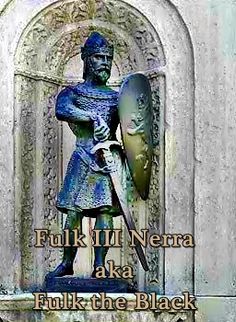Fulk Nerra’s fortress strategy greatly expanded Anjou. He constructed a network of castles, fortified houses, and towns no more than a day’s march apart, to surround and isolate his enemies. The map shows the defensive beginnings and later offensive momentum which this strategy of conquest generated.
For over half a century, from 980 to around 1030, Fulk Nerra dominated his county by means of a fortress strategy. At first this was defensive. His greatest competitor was Odo I, count of Blois, and ruler of the important city of Tours. Odo also controlled Saumur, so cutting off Angevin contact with the Touraine. In 992-94, Fulk constructed Langeais to secure a route south from Angers. He also drew upon his father’s alliance with Bouchard of Vendome to outflank Tours. His prime aim was to establish lines of communication with his southern fortresses of Loudun, Loches, and the Vienne valley. There was a risk that Fulk’s vassals might transfer their allegiance to the count of Blois to preserve their lands; their defenders could submit to a besieger without penalty – only if they held out would they suffer massacre. So, Fulk’s fortifications acted as staging posts, both defensible refuges and bases for supporting advances. They needed to be within a day’s march of one another; no more than 20 miles (32 km) apart.
The sudden death of Odo in 996 allowed Fulk to take the initiative. He seized control of the Loire valley from Montsoreau to Amboise; but he had overreached himself. The new king of France, Robert, married Bertha of Blois and recaptured the city. Fulk learnt his lesson and was a most scrupulous vassal thereafter. He worked instead on developing a secure route through the northern Touraine to Amboise, constructing and rebuilding castles a day’s march apart at Semblançay, Chateau-la-Valliere, and Bauge. Once again this was defensive, while the fortification of a domus (house) at Morand to harass communications between Tours and Chateau Renault was aggressive.
South of the Loire, Fulk was strong in the valleys of the Indre and Vienne, but lacked a good link from Angers to Vihiers above the Layon. The situation was worsened by the defection of his previous ally, viscount Aimeri of Thouars, in 994. Needing a link to Loudun, Fulk began by fortifying Passavant and Montglan, a little further east. Montreuil-Bellay was only constructed c. 1030, after the fall of Saumur. Its castellan, Berlaius, and his garrison of caballarii (mounted warriors) were tasked with protecting the area from attacks by the men of Thouars.
Meanwhile, following the loss of Tours in 997, Fulk began to encircle the city, building Montbazon in the same year. The castle also operated against the Blesois communications between Tours and lIe-Bouchard and, in co-ordination with the garrison of Langeais, against Chinon. Soon after 1000, Fulk established a castle southeast of Tours at Montresor. Montrichard was constructed c. 1005 to increase the pressure on St Aignan, a castle captured later and used as a base for further penetration of the Cher valley. Odo II’s campaigns to recover St Aignan led to his defeat by Fulk at the battle of Pontlevoy in 1016.
In the west, Fulk used his vassals effectively, with Renaud controlling Champtoceaux c. 998, and Drogo in Chateaupanne c. 1006. Montjean was constructed shordy afterwards. St Florent-le-Vieil completed the defence of the Loire in the 1030s. Pushing south, Montrevault was established at the same time and later, in the 1020s, Montfaucon and La Tour Landry stood against hostile Thouars. Mirebeau, built c. 1000, protected the southern march from attack from Poitiers. Fulk’s influence may have spread even further south, supporting the lord of Parthenay in constructing that castle (c. 1012) and later an outpost at Germond (1026). The strength of William V, count of Aquitaine, meant that it was advisable to use a less direct strategy than that employed against the count of Blois.
In the north, Fulk built upon the position established by his father at Sable. Chateau-Gontier, on the Mayenne, and Chateau du Loir were constructed after 1005 against Le Mans. Most of the castles were built in the 1010s and 1020s, establishing a deep frontier, or limes, along the river Loir. It is possible to identify several strategic groupings of castles in a similar fashion, defending Fulk’s territories. Of course, these did not form a rigid defensive line, rather a flexible defence-in-depth against the chevauchee. In 1026 and 1027, Odo II of Blois penetrated as far as Saumur, which had fallen to Fulk in the former year – but to no avail.
Castle garrisons were not intended to challenge an invading force, rather to harass it. Unless the attacker wished to commit his forces to siege, and risk being surprised by a relief force, he could achieve little. Fulk avoided battle and preferred to develop a strategic stranglehold through his fortifications. The final result, although not in his lifetime, was the conquest of Tours in 1044, after a half-century of pressure.
